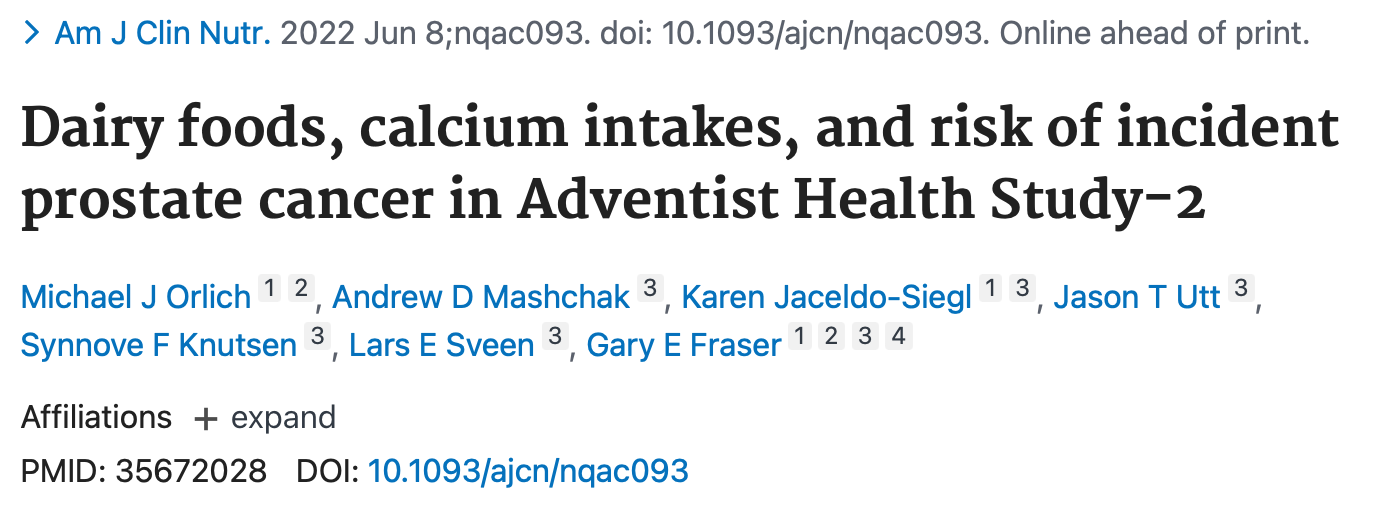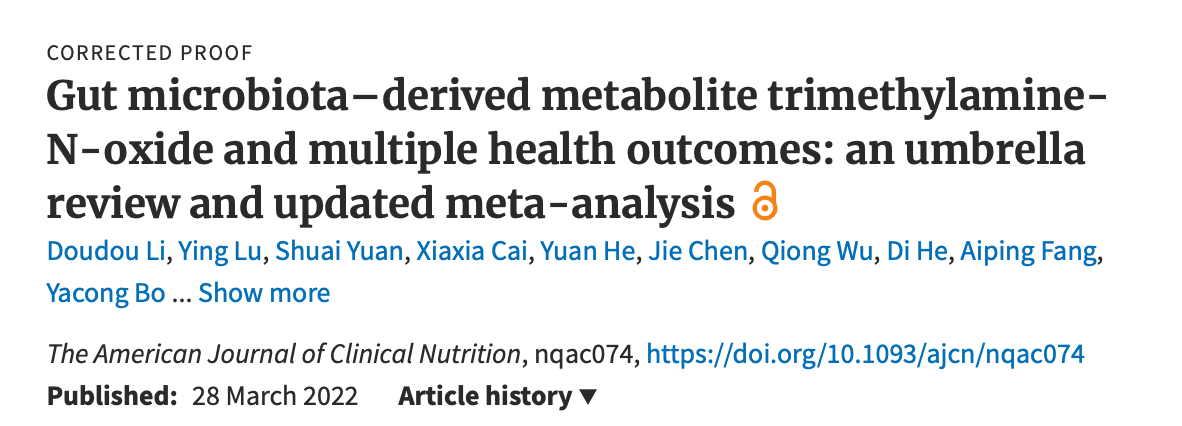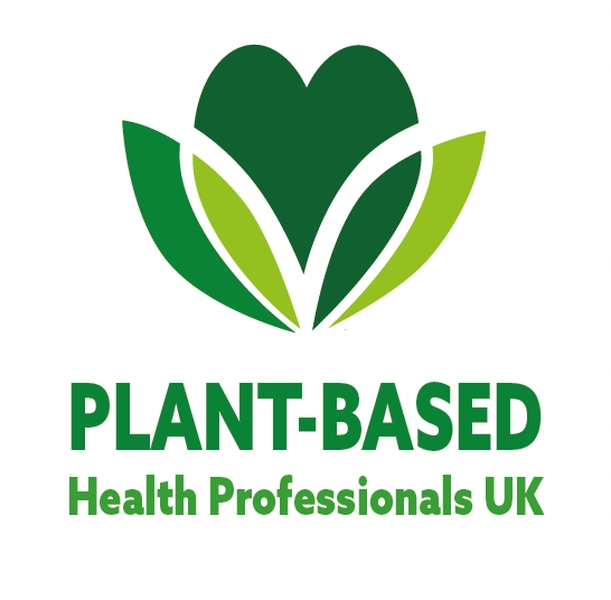A review of the week’s plant-based nutrition news 19th June 2022
This week I cover a new study on dairy and prostate cancer risk, diet and healthy ageing, TMAO concentrations and health outcomes, nut consumption and kidney disease and time-restricted eating after cancer treatment.

DAIRY CONSUMPTION AND PROSTATE CANCER: We have known for a while that there may be is an association between dairy consumption and an increased risk of prostate cancer. This is acknowledged by the World Cancer Research Fund but the strength of evidence is considered weak or limited given that not all studies confirm this association and a dose response is not always apparent. In their summary they state that in general, studies show that 400g (386ml milk) of total dairy consumption per day increases the risk of prostate cancer by around 7%. It has been postulated that it may be the calcium in dairy that causes this increased risk given that there are also data suggesting higher consumption of calcium from all sources increases the risk of prostate cancer. The mechanism may be that higher intakes of calcium down regulates the formation of vitamin D3, which drives cell proliferation. The other proposed mechanism is that higher exposure to the growth factor IGF-1 through dairy consumption is increasing cancer risk.
It is good to have this analysis from the Adventist Health Study-2 cohort in which researchers have assessed the contribution of both dairy consumption and calcium separately, with the inclusion of participants who are vegan and thus do not consume dairy and obtain calcium from alternate sources. The study included 28,737 Seventh-day Adventist men in the United States and Canada, of whom 6389 were of black ethnicity. 11.7% (3370 participants) had very low (≤10 g/d) or no intake (2302 participants) of dairy. In total, 1254 (190 advanced) cases of prostate cancer were diagnosed during an average 7.8 years of follow-up. Participants were analysed in quintiles of dairy consumption with comparisons made between the midpoints of the upper and lower quintiles of dairy consumers (430 versus 20.2 g/d).
The results showed that men consuming 430g/d of dairy compared to those consuming 20.2g/d had a 27% increased risk of developing prostate cancer. The association was similar for advanced and non-advanced cases of cancer, in people of black ethnicity and after excluding vegans from the analysis. The major rise in risk of prostate cancer was seen to occur between the zero intake category and second quintile of the dairy users, with the risk then remaining high but plateauing. Compared to participants consuming zero dairy, those consuming the most had a 60% increased risk. The increased risk was mainly seen with the consumption of milk with no association found for cheese and yogurt. In contrast, higher intakes of non dairy and supplemental calcium did not increase the risk of prostate cancer.
The authors conclude ‘these data from a population with a wide range of dairy and calcium exposure do not clearly support a connection between calcium intake and prostate cancer. However, they do suggest that risk of prostate cancer is causally associated with higher intake of dairy products or some unknown causal factor that is strongly associated with dairy intake’. I think its time to seriously rethink our reliance on dairy for nutrients. We can definitely do better.

DIET AND LONGEVITY: We know that healthy diet and lifestyle factors are associated with a longer life free of chronic illness. So, no surprises with the results of this study from Israel, which examined the association between diet quality and longevity and successful ageing in a population-based cohort of 1770 adults aged>/=65 years. Diet was assessed using the Healthy Eating Index (HEI-2015) with scores ranging from 0 (worst diet) to 100 (best diet). The HEI-2015 includes 13 dietary components; 9 adequacy components (those recommended for inclusion in a healthy diet), including total fruits, whole fruits, total vegetables, greens and beans, whole grains, dairy, total protein foods, seafood and plant proteins, and fatty acids, and 4 moderation components (to be consumed sparingly), including refined grains, sodium, added sugars, and saturated fats.
The results showed that healthier diets were associated with healthier lifestyles and higher socioeconomic status. During the 12.6 years of follow-up, higher diet quality score was associated with a significant 15% reduction in risk of mortality and positively associated with successful ageing, defined as preserved physical and cognitive function and robust mental health, with a dose-dependent effect. This association remained significant after adjusting for other healthy lifestyle and socioeconomic factors. The authors conclude ‘the available information highlights the need for public health intervention with a “never too late” attitude. Raising awareness of the future benefits of healthy food choices, in addition to providing healthy alternatives and dietary education, could lead to successful ageing outcomes in the older adult population’.
An important study published earlier this year analysed a large amount of dietary data and found that at every age and stage of life a healthy diet could add healthy years to life with the greatest gains apparent for those eating the most legumes, whole grains and nuts, and the least red and processed meat.
Sadly, in the UK and in many other high incomes countries we are spending more years in ill health at the end of life and the situation is worsening, being further exacerbated by socioeconomic inequalities. A new report from the UK has shown that healthy life expectancy is men is now 62.4 years and in women 60.9, well before the expected retirement age. There are many actions that are required to address this issue, with access to healthy food being just one.

TMAO AND HEALTH OUTCOMES: Trimethylamine-N-oxide (TMAO) is a metabolite derived from the action of gut microbiota on certain dietary components, including phosphatidylcholine, choline, betaine, and carnitine, which are abundant in seafoods, dairy products, egg yolks, muscle, and organ meats. These nutrients are converted by gut bacteria to trimethyl amine (TMA) and then converted by the liver to TMAO. We have a large number of studies spanning more than a decade reporting a negative association between higher circulating concentrations of TMAO and various health outcomes. However, the causal nature of this relationship has been called into question given that mendelian randomisation studies have not been able to confirm this.
An umbrella review is designed to provide a comprehensive overview of evidence from systematic reviews with or without meta-analysis. In this umbrella review, all meta-analyses on the associations between plasma TMAO concentrations and health outcomes were identified and the final analysis included data from 24 meta-analyses for 15 unique health outcomes, including all-cause mortality, cardiovascular outcomes, diabetes, cancer risk, blood pressure and other cardiometabolic biomarkers and renal function.
There are a lot of data in this paper so it is worth taking the time to read the full report. The headline summary is that higher concentrations of TMAO were found to be associated with an increased risk of a number of adverse health outcomes. When just cohort studies were considered, the strongest associations were for an increased risk of all-cause mortality, cardiovascular events, hypertension, cardiovascular disease mortality, systolic blood pressure, CRP, cholesterol, diabetes and renal function. Although the results are only able to confirm a negative association rather than prove causality, it is useful to observe the consistency of the data. The author conclude ‘Further studies are needed to investigate whether circulating TMAO concentrations could be an intervention target for chronic disease’.
Whilst waiting for intervention studies in this area of research, we know that dietary factors are hugely important for determining circulating TMAO levels. As stated by the authors, we know ‘paleolithic diet, high-fat diet, and high protein diet promote increased TMAO concentrations’. Whereas the opposite is true for plant-based diets which are associated with significantly lower levels of TMAO.

NUT CONSUMPTION AND KIDNEY DISEASE: Nuts are a hugely beneficial component of any healthy diet pattern and a core part of a healthy plant-based diet. Regular nut consumption is strongly associated with better heart health but studies have also shown broader benefits for the prevention of other chronic conditions and for reduction in mortality.
The health benefits are likely due to the array of healthy nutrients they contain including being rich in dietary potassium, a key source of micronutrients (antioxidants) and dietary fibre, high in mono- and poly-unsaturated fatty acid and lower saturated fat content and containing more plant omega-3 fatty acids, including alpha-linolenic acid.
The high phosphate and potassium content of nuts has traditionally led to unsubstantiated recommendations to avoid nuts in chronic kidney disease (CKD) but there has been little research to date on the impact of nut consumption for kidney health.
The current study investigated the association between frequency of nut consumption with the prevalence of CKD as well as the risk of all-cause and CVD mortality among 6,072 adults from the US National Health and Nutrition Examination Study (NHANES) cohort surveyed over 2003–2006. 1,203 participants had CKD and 4,869 participants did not have CKD. Frequency of nut consumption in the preceding 12 months was categorised as (1) never, (2) 1–11 times per year, (3) 1–3 times per month, (4) 1–6 times per week, and (5) more than once a day, with those who have never consumed nuts as the reference group.
The results showed that consuming nuts 1–6 times per week was associated with a 33% lower prevalence of CKD after accounting for a number of potential confounders. Higher nut consumption was also significantly associated with lower all-cause and CVD mortality in the non-CKD participants. Amongst the CKD participants, those who consumed nuts 1–6 times per week had a 37% lower risk of all-cause mortality.
Of course this study is observational and has many limitations, however it does add to our knowledge base and continues to support the consumption of nuts for preventing CKD. In addition, given that cardiovascular disease is the commonest cause of death in people with kidney disease, incorporating nuts into a healthy plant-predominant diet seems eminently sensible. The general consensus for a healthy diet for kidney health is a plant-dominant low-protein or PLADO diet consisting of dietary protein intake of 0.6–0.8 g/kg/day with ≥50% from plant-based sources.

TIME-RESTRICTED EATING AND BREAST CANCER: This is a small, hypothesis generating study. There has been great interest in the role of various types of fasting in the treatment of people living with cancer. This study investigated whether limiting eating to an 8 hours window could lower the risk of cardiovascular disease in older women with cardiometabolic risk factors who have survived a diagnosis of breast cancer survivors
The study included 22 individuals with a body mass index who were classified as overweight or obese, had completed cardiotoxic treatment (anthracyclines, a commonly used chemotherapy drug) within the past one to six years, and were an average age of 66 years. For eight weeks participants were allowed to eat freely between 12–8 pm on weekdays and at any time on the weekends. Outside of those hours, participants were asked to consume only water, black coffee or black tea. Using the Canadian Cardiovascular Society scoring system to calculate the 10-year Framingham Risk Score, the authors found that cardiovascular disease risk decreased from 10.9% to 8.6% at the end of the trial period.
At baseline, 15 of 22 participants (68%) were classified as cardiometabolically unhealthy, defined as meeting the criteria for metabolic syndrome or for pharmacologic preventive treatment of CVD risk (ie, statins) according to Canadian Cardiovascular Society guidelines. Following the 8-week intervention, 8 of 15 (53%) no longer met the criteria for pharmacologic treatment of CVD risk (ie, reclassification to “low” [<10%] Framingham risk) or metabolic syndrome.
This requires further study but it is interesting to see how just changing when you eat rather than what you eat could have a beneficial impact.
Please follow my organisation ‘plant-based health professionals UK’ on Instagram @plantbasedhealthprofessionals and facebook. You can support our work by joining as a member or making a donation via the website.
